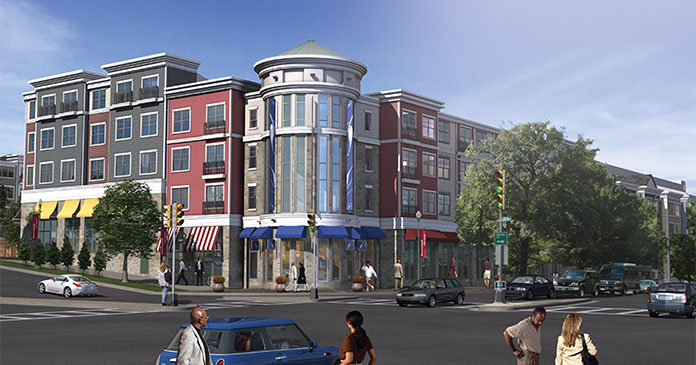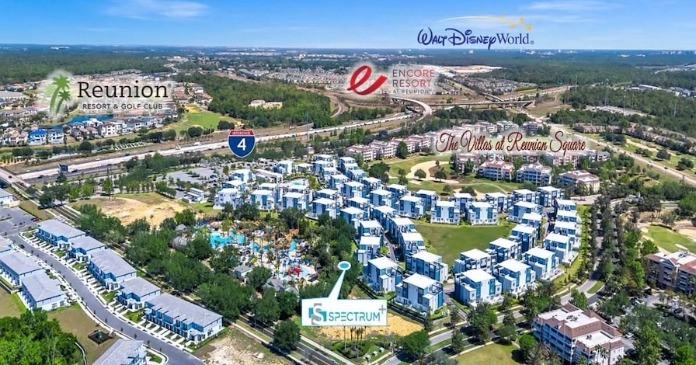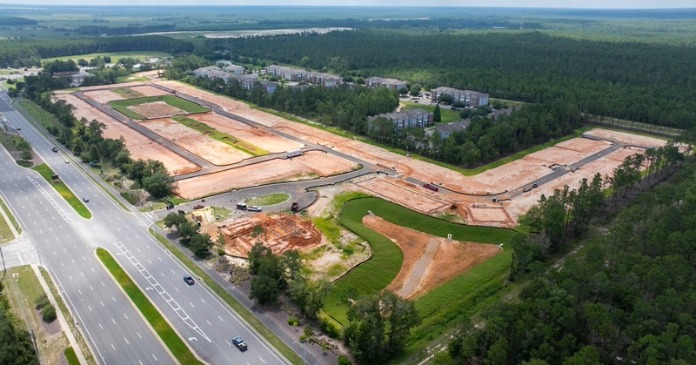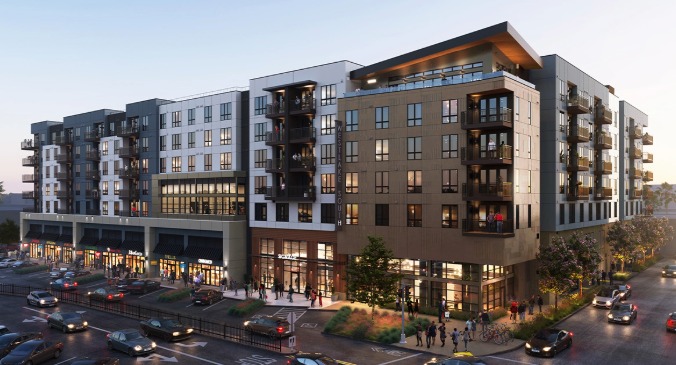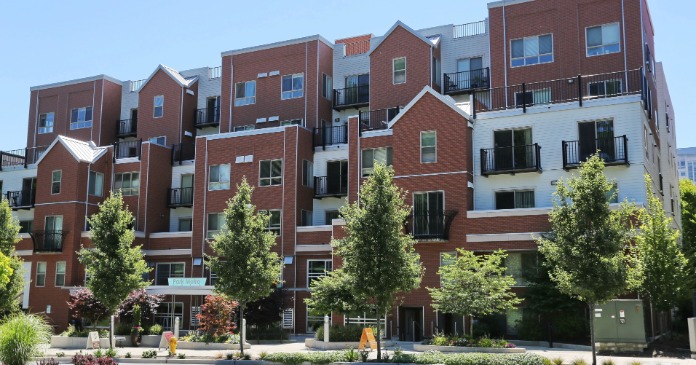The project is a major step toward revitalizing a mostly industrial neighborhood that has been overlooked by developers for years, partly because of the inordinate amount of time required to change zoning, said Victoria Davis, president of Urban Atlantic. That Bethesda, Md.-based development firm was founded in 1998 as the Mid-City Legacy family of companies and rebranded in 2008 to reflect the company’s commitment to East Coast urban markets extending from Florida to Connecticut. The company has completed real estate developments totaling over $1.1 billion in value.
Prior to joining Urban Atlantic in 1997, Davis served as deputy director of the Maryland Housing Fund. Before that, she worked before at MNC Financial-South Charles Realty, where she was responsible for troubled loan resolutions and disposition of a large portfolio of land, multifamily and single-family properties. She also oversaw acquisition, development and asset management of multifamily market rate and mixed-income developments for Trammell Crow Residential, before joining MNC.
A&R is a family-owned and operated group of businesses spanning more than 30 years of real estate development, construction and property management, founded by William L. Adams and Theo C. Rodgers. Led by two generations of the Rodgers family today, the company has provided development and construction services for more than 8,500 residential, senior living and student units and more than one million sq. ft. of office, retail and community space and thousands of structured parking spaces.
Despite their combined 60 years of experience, the long process required to get Rhode Island Station underway has been an exercise in perseverance and patience for the developers, who were selected in 2001 over two other bidders in a competitive solicitation by the Washington Metropolitan Transit Authority and awarded a 60-year ground lease and rights to develop the site.
The partners won final zoning approval from the D.C. Office of Planning in April 2007 and scheduled the project for a 2008 start date with completion last summer. But the economic crisis and the credit freeze caused a number of delays in securing the necessary funding.
The team successfully cobbled together an intricate financing package in the worst economic environment in recent history. “In an essentially frozen credit market, our experience in public-private finance became crucial. Because we’ve been in the urban market for several decades, mixed finance is our bread and butter. The Rhode Island Station structure is one of the most complex that we’ve put together, and we are grateful to each of our partners for thinking ‘outside of the box’ to make this project happen,” said Davis.
The project is being financed by the HUD FHA program, U.S. Department of the Treasury New Markets Tax Credits program, District of Columbia PILOT financing for the metro commuter garage, US Bank, Low Income Investment Fund (LIIF), Mid-City Community CDE, an affiliate of Urban Atlantic, and sponsor equity.
It also is the first private project nationally to combine FHA financing—typically used for multifamily—with the U.S. Treasury’s New Markets Tax Credits that typically are used for non-residential applications.
“We used an FHA mortgage on the entire property through the HUD 220 program, New Markets Tax Credits on the entire property and a payment in lieu of taxes and also private sponsor equity from us. It’s a smorgasbord of financing tools and obviously very large,” said Davis.
The HUD 220 program insures loans for multifamily housing projects in urban renewal and code enforcement areas and other areas where local governments have undertaken designated revitalization activities. “It is a really old program and hasn’t been that frequently used, but it allows you to use HUD financing on a mixed-use development like ours with retail on the first floor and three levels of residential above that. Ours is not a typical multifamily deal,” said Davis.
Working with community
Without housing subsidies of any kind, the developers set aside 20 percent of the units for residents earning 50 percent of the area median income and designated 10 percent of the retail to local businesses.
“I think that was really important in terms of working with the community and making sure that when you go in and do neighborhood revitalization that it doesn’t turn into gentrification, that it really is a revitalization that is open to all,” said Davis.
“A lot of government workers live in Ward 5 and there are a lot of established neighborhoods. But, on the other hand, to be eligible for New Markets Tax Credits, it is an area that is categorized as highly distressed, given unemployment and poverty numbers. There is a fair bit of subsidized housing in Ward 5, but what’s really exciting about this site is that there is an incredible Home Depot and a new Giant Food store right next door on a site that used to be an impound lot, so we have shadow anchors right at the site. It is the only Home Depot in Washington D.C. and that’s significant, all the rest are in the suburbs,” she said.
The shape of things to come
Rhode Island Station, designed by the Lessard Group, Inc., is a “Texas-wrap” or “donut,” consisting of two buildings that flank a main street and parking structures that are wrapped on four sides by one building and on three sides by another.
The developers plan to start the first building about three months prior to the second building and deliver floor by floor to ensure a steady stream of deliveries, beginning 18 months into the project and continuing through month 24.
During the entire building process, general contractor The Bozzuto Group must maintain traffic through the site that serves one of the most heavily used metro stations in the entire system.
“I think we have more than 5,000 pedestrians a day and 12,000 transit patrons, both on bus routes and on the metro that is located here, so it’s a pretty urban location and has all the challenges that go with that, including intense management to be able to deliver the product in a timely way,” said Davis.
The one-, two- and three-bedrooms averaging 800 sq. ft. include large windows, walk-in closets and one bathroom per bedroom. Market-rate rents are underwritten at $2.25. The amenity deck that will sit atop the retail component features a green rooftop with a swimming pool and a first-class clubhouse. Other amenities include energy efficient systems and shopping and dining venues along a tree-lined boulevard.
Sustainable scoring
Davis said the company went through a self-scoring for LEED and scored in the Silver range, but chose not to pursue certification because the building was designed before that rating system was in place and attaining the label would have added $150,000 to the project cost. “We took a look at it to make sure we did our best in terms of the occupancy for our tenants, but we didn’t feel we needed to be labeled to be successful,” said Davis.
The developers were careful to orient the buildings in a way that would facilitate retroactive installation of solar PV to power common areas. “Our roofs are at a 4/12 pitch, perfect for solar orientation and facing due south. And, although it’s not yet part of the plan, the siting of buildings is in compliance with LEED’s requirement. We actually do get a fair share of sun and our city is very progressive and has PACE energy financing in place,” she said.
The PACE program, typically funded by bonds, gives property owners the ability to finance energy efficiency and renewable energy installations on existing buildings through real estate tax assessment.
“It’s a really big deal because you can get low-cost financing charged through real estate taxes. Some cities only have it available for homeowner properties, but we have it for commercial. Our building stock is a little bit older than most in the country because D.C. is a relatively old city. PACE legislation just went through and the city has a huge grant in to Department of Energy because they really think that there is way to retrofit the buildings in the city and bring in renewable energy to help us mitigate our carbon footprint and our utility usage. It’s an important thing for our city and something I would really hope to take advantage of here,” said Davis.
Author Wendy Broffman


